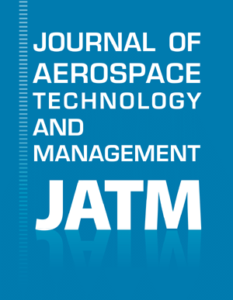Eurico Rodrigues de Paula, Senior Researcher, National Institute for Space Research – Division of Heliophysics, Planetary Sciences and Aeronomy (DIHPA), São José dos Campos, SP, Brazil.
 The article A Retrospective of Global Navigation Satellite System Ionospheric Irregularities Monitoring Networks in Brazil, published in the Journal of Aerospace Technology and Management (vol. 15), presents the ionospheric scintillation monitor networks whose data are used to mitigate and predict the effects of these scintillations on the air, land and sea satellite positioning and navigation systems using the GNSS satellite. Among many other applications of this system, we can mention precision agriculture, the positioning of oil prospecting and extraction platforms in deep waters and the georeferencing of rural properties. New applications are emerging day by day.
The article A Retrospective of Global Navigation Satellite System Ionospheric Irregularities Monitoring Networks in Brazil, published in the Journal of Aerospace Technology and Management (vol. 15), presents the ionospheric scintillation monitor networks whose data are used to mitigate and predict the effects of these scintillations on the air, land and sea satellite positioning and navigation systems using the GNSS satellite. Among many other applications of this system, we can mention precision agriculture, the positioning of oil prospecting and extraction platforms in deep waters and the georeferencing of rural properties. New applications are emerging day by day.
It is known that the Earth’s ionosphere causes delay in the GNSS signal due to total electron content (TEC), as well as causing phase and amplitude scintillation in this signal when ionospheric plasma irregularities are present. In Brazil these irregularities occur after sunset, from September to April and with greater intensity and frequency during the period of high activity of the 11-year solar cycle.
This scintillation can cause deleterious effects on GNSS positioning in tropical regions across the globe, mainly in regions that are under the peaks of the Equatorial Ionization Anomaly (EIA) that are located around 15 magnetic degrees north and south of the magnetic equator. Therefore, it is important to evaluate the effects of the ionosphere on the GNSS signal. It should be noted that in Brazil a National Institute of Science and Technology (INCT GNSS-NavAer) was created with the participation of several Brazilian and international institutes and universities to increasingly develop this technology.
Research on ionospheric irregularities has been carried out using theoretical and semi-empirical computational models and, mainly, using data from several sounders located on the ground and on board satellites. Therefore, it is necessary to have a large spatial and temporal coverage of data, and GNSS receivers are of great importance due to their global coverage and availability. This study presents a retrospective of scintillation monitor networks in Brazil and their characteristics.
As the Brazilian Continuous Monitoring Network (RBMC), administered by the Brazilian Institute of Geography and Statistics (IBGE), provides the Total Electronic Content (CET), it is possible from this parameter to calculate the CET temporal variation index (ROTI) that is well correlated with ionospheric irregularities. These RBMC GNSS receivers provide data in regions with a shortage of scintillation monitors. Data from scintillation monitors and RBMC are stored at UNESP in Presidente Prudente and mirrored at National Institute for Space Research (INPE), using the Ionospheric Scintillation Monitor Receivers (ISMR) Query Tool, which is a web software for searching data from scintillation monitors.
A major challenge is to keep the scintillation monitors in proper operation and transmitting their data, as they are installed in several sites throughout the national territory, including in regions of difficult access such as the Amazon. Despite all these difficulties, our perspective is to increase more and more the number of scintillation monitors to contribute to the systems that use the GNSS signal to operate safely even during the incidence of ionospheric scintillation. An overview of this project, the main results and future challenges are presented in the article entitled The GNSS NavAer INCT Project Overview and Main Results, already published in the Journal of Aerospace Technology and Management (vol. 14).
Listen to the following podcast (in Portuguese) by Eurico Rodrigues de Paula expanding the discussion on the Global Navigation Satellite System.
References
MONICO, J.F.G., et al. The GNSS NavAer INCT Project Overview and Main Results. J Aerosp Technol Manag [online]. 2022, vol. 14, e0722 [viewed 23 March 2023]. https://doi.org/10.1590/jatm.v14.1249. Available from: https://www.scielo.br/j/jatm/a/ZKdy3YGSRznxgnHSrSRDkZx/
To read the article, access
PAULA, E.R., et al. A Retrospective of Global Navigation Satellite System Ionospheric Irregularities Monitoring Networks in Brazil. J Aerosp Technol Manag [online]. 2023, vol. 15, e0123 [viewed 23 March 2023]. https://doi.org/10.1590/jatm.v15.1288. Available from: https://www.scielo.br/j/jatm/a/S5FnFwF73JD9qRnLDX3GXnH/
External links
Journal of Aerospace Technology and Management – JATM : https://www.scielo.br/j/jatm
Universidade Estadual Paulista (Unesp), Faculdade de Ciências e Tecnologia, Campus de Presidente Prudente: www.fct.unesp.br
GNSS-NavAer: https://inct-gnss-navaer.fct.unesp.br/pt/
ISMR Query Tool: https://ismrquerytool.fct.unesp.br/
Divulgação do INCT GNSS-NavAer: https://youtu.be/-CsR6pRkxQQ
Como citar este post [ISO 690/2010]:














Recent Comments